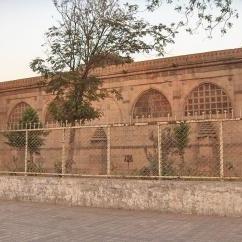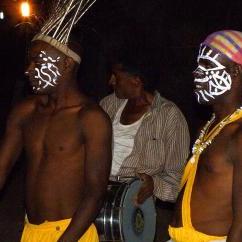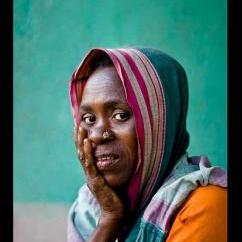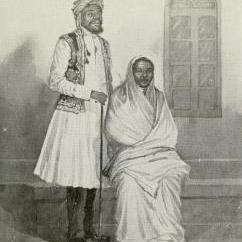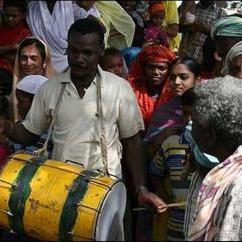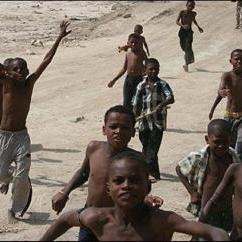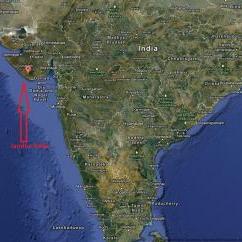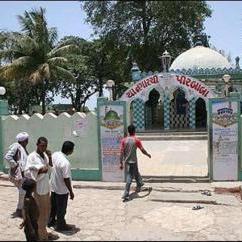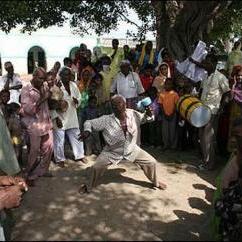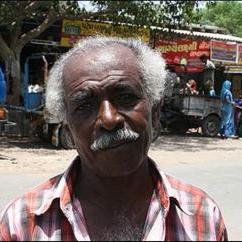
Long before the first slave ships started supplying labor to the cotton plantations of the American- south, and many centuries before the first Africans were brought ashore to the sugar estates of Brazil and the Caribbean, the sea trade between east and Southern Africa, and Gujarat in India was established. For over 2000 years Africans were being sold as slave-soldiers for India's princely states or were recruited as personal bodyguards, servants and musicians for many of India's kings and princes. In some parts of the country Sidis even rose to be powerful generals or kings themselves. Their descendants are the least visible part of the huge African diaspora. But today in India, almost lost among the mosaic of different cultures and communities in that country, are tens of thousands of people of African descent. They are known as Sidis.
Although they came at first as slaves, they were so successful as fighters that they at times usurped power from the rulers they were supposed to be serving. Most have lost touch with their roots, yet they are now struggling at the margins of Indian society. "The Sidis are descendants of African slaves, sailors and servants, and merchants who remained in India after arriving through the sea trade with East Africa and the Gulf," says Amy Catlin of the University of California, who is making a special study of Sidi culture. "That was a process which began in the 12th century or before, and lasted until the late 19th century".
Some Sidis are keenly aware of their past, and a few remain in touch with relatives in Africa. But in the western Indian state of Gujarat - where most Sidis live - the community has lost touch with its roots. The village of Jambur, deep in the Gir forest, is one of two exclusively Sidi settlements. It is miserably poor. The headman explains that yes, everyone in Jambur is a Sidi. Their forbears came from Africa. But they have lost any knowledge of African languages, and don't know where exactly their ancestors came from. The only remnant they retain of their African lineage is their music and dance.
Professor Catlin, an ethno-musicologist, hopes to fill in the story of the Sidis their music and dance. "In Gujarat, the affinities with African music, include certain musical instruments and their names", she says, "and also the performance of an African-derived musical genre called "goma". E.g. one of the Sidis’ strongest remaining links to their roots is the damaal or drum. Otherwise Sidi culture is not significantly different to that of other poor, rural Indians. "The damaal comes from Africa," explains Yunus, a blind man who is the chief drummer of Jambur. "The skill of playing has been passed down from father to son. It is a gift from God," he says.
Hassan Bhai of Jambur says his forefathers came from Mozambique to serve in Portugal's colonial army which controlled a nearby port. But most Sidis have little idea of where their families came from. "The children don't know anything about Africa because those who knew about Africa have died," Hassan says.
Every evening Yunus leads Jambur's musicians and dancers to a shrine outside the village. Like most Sidis, the people of Jambur are Sufi Muslims, who believe God is worshipped through song and dance. Anthropologists believe the dancers' ecstatic performances are a combination of traditional African worship and Indian Sufi practices.
Jambur is an impoverished village. The people work as laborers for neighboring farmers. They also receive help from the government under an affirmative action program for poor communities. Jambur was settled by the families of Sidi soldiers of the former ruler, or Nawab, of the area.
Sidis and Indian Muslims come from hundreds of kilometres away to worship at the shrine at Jambur. The shrine in Jambur houses the tomb of a saint known as Nagarchi Baba - Drum Master. The Sidis say he was an Arab who visited Africa some 900 years ago, before settling in India. The Sidis also worship another Sufi saint at the shrine, known as Bava Gor, a Nigerian bead merchant.
In the nearby town of Junagadh, a smaller group of Sidis lives alongside the shrine of Bava Gor, an ancient Sufi Muslim holyman who was himself of African descent. Their hold on their African past is a little more secure. They say they know a few songs in an African language, but not their meaning. And their dance is more obviously African. But again, their music, song and dance are the only links with their African past.
Amy Catlin believes that the Sidis of western India came from coastal and inland villages in east Africa which were raided by slave traders. But that's far from certain. Indeed, one legend has it that the Sidis of inland Gujarat originally came from Kano in northern Nigeria, and ended up in India after undertaking a Hajj pilgrimage to Mecca. Music may be the only key that can unlock their past.
The Siddi, Siddhi, or Sheedi (Urdu: شیدی ; Hindi, Marathi, Konkani: सिद्दी or शीदि/ಸಿದ್ಧಿ; Gujarati: સિદ્દી; Kannada: ಸಿದ್ಧಿಗಳು), also known as Habshi, are an Indian and Pakistani ethnic group of Black African and/or Afro-Arab descent. The Siddi population is currently estimated to be 20,000–55,000, with Gujarat and Hyderabad in India and Makran and Karachi in Pakistan as the main population centres. Siddis are mainly Sufi Muslims, although some are Hindus and some Roman Catholic Christians. Villages in the forests of northern Karnataka, for instance, have residents who likely are descended from Mozambican/Angolan slaves who escaped from Portuguese traders and ships.
There are conflicting hypotheses on the origin of the name Siddi. One theory is that the word was a term of respect in North Africa, similar to the word sahib in modern India and Pakistan. A second theory is that the term Siddi is derived from the title borne by the captains of the Arab vessels that first brought Siddi settlers to India. These captains were known as Sayyid.
Similarly, another term for Siddis, habshi (from Al-Habsh, the Arabic term for Abyssinia), is held to be derived from the common name for the captains of the Ethiopian/Abyssinian ships that also first delivered Siddi slaves to the subcontinent. The term eventually came to be applied to other Africans and not only to emancipated Siddis. In time, it came to be used to refer to their descendants as well. It is sometimes pronounced "Hafsi" and is considered an insult.
Siddis are also sometimes referred to as Afro-Indians. Siddis were referred to as Zani by Arabs; in China, various transcriptions of this Arabic word were used, including Xinji (辛吉) and Jinzhi (津芝).
The first Siddis are thought to have arrived in India in 628 AD at the Bharuch port. Several others followed with the first Arab Islamic invasions of the subcontinent in 712 AD. The latter group are believed to have been soldiers with Muhammad bin Qasim's Arab army, and were called Zanjis.
Most Siddis, however, are believed to be the descendants of slaves, sailors, servants and merchants from East Africa who arrived and became resident in the subcontinent during the 1200-1900 AD period. A large influx of Siddis to the region occurred in the 17th century when Portuguese slave traders sold a number of them to local princes.
In Western India (the modern Indian states of Gujarat and Maharashtra), the Siddi gained a reputation for physical strength and loyalty, and were sought out as mercenaries by local rulers, and as domestic servants and farm labor. Some Siddis escaped slavery to establish communities in forested areas, and some even established small Siddi principalities on Janjira Island and at Jaffrabad as early as the twelfth century. A former alternative name of Janjira was Habshan (i.e., land of the Habshis). In the Delhi Sultanate period prior to the rise of the Mughals in India, Jamal-ud-Din Yaqut was a prominent Siddi slave-turned-nobleman who was a close confidant of Razia Sultana (1205–1240 CE). Although this is disputed, he may also have been her lover.
As a power centre, Siddis were sometimes allied with the Mughal Empire in its power-struggle with the Maratha Confederacy. However, Malik Ambar, a prominent Siddi figure in Indian history at large, is sometimes regarded as the "military guru of the Marathas", and was deeply allied with them. He established the town of Khirki which later became the modern city of Aurangabad, and helped establish the Marathas as a major force in the Deccan. Later, the Marathas adapted Siddi guerrilla warfare tactics to grow their power and ultimately demolish the Mughal empire. Some accounts describe the Mughal emperor Jahangir as obsessed by Ambar due to the Mughal empire's consistent failures in crushing him and his Maratha cavalry, describing him derogatorily as "the black faced" and "the ill-starred" in the royal chronicles and even having a painting commissioned that showed Jahangir killing Ambar, a fantasy which was never realised in reality.
Some Indian Siddis are descended from Tanzanians and Mozambicans brought by the Portuguese. While most enslaved African people became Muslim and a small minority became Christian, very few became Hindu since they could not find themselves a position in the traditional Hindu caste hierarchy
The Siddis of Gujarat were supposedly presented as slaves by the Portuguese to the local Prince, Nawab of Junagadh, the Siddis also live around Gir Forest National Park and Wildlife Sanctuary, the last refuge in the world of the almost extinct Asiatic Lions, in Junagadh a district of the state of Gujarat, India.
On the way to Deva-dungar is the quaint village of Sirvan, inhabited entirely by Siddis, a tribe of African people. They were brought 300 years ago from Africa, by the Portuguese for the Nawab of Junagadh. Today, they follow very few of their original customs, with a few exceptions like the traditional Dhamal dance.
Although Gujarati Siddis have adopted the language and many customs of their surrounding populations, some African traditions have been preserved. These include the Goma music and dance form, which is sometimes called Dhamaal (Gujarati: ધમાલ, fun). The term is believed to be derived from the Ngoma drumming and dance forms of Bantu East Africa. The Goma also has a spiritual significance and, at the climax of the dance, some dancers are believed to be vehicles for the presence of Siddi saints of the past.
The Siddis of Karnataka (Kannada: ಕರ್ನಾಟಕದ ಸಿದ್ಧಿಗಳು) (also spelled Siddhis) are a tribe of African descent that has made Karnataka their home for the last 400 years. There is a 50,000 strong Siddhi population across India, of which more than a third live in Karnataka. In Karnataka, they are concentrated around Yellapur, Haliyal, Ankola, Joida, Mundgod and Sirsi taluks of Uttara Kannada and in Khanapur of Belgaum and Kalghatgi of Dharwad district. Many members of the Siddis community of Karnataka had migrated to Pakistan after independence and have settled in Karachi, Sindh. The majority of the Siddhis in Karnataka are descendants of Siddhi slaves who were brought from East Africa (mostly Mozambique) and Ethiopia to Goa by the Portuguese, British and the Arabs between the 16th and 19th centuries. During the Goan Inquisition, some of these slaves were freed and some escaped into the forests of the neighbouring Karnataka state. It has been reported that these Siddis believe that Barack Obama shares their genepool and that they wanted to gift a bottle of honey to him on his visit to India in 2010.
The Siddis of Hyderabad, India: In the 18th centur y the Siddi Coummunity was established in Hyderabad the 18th by the Arab Siddi community diaspora, who used to serve as a Cavalry Guards of Asif Jahi Nizams irregular army. Asif Jahi Nizams had patronized them with rewards and there music called Marfa Music got popular which was performed during there official celebrations and ceremonies.
Sheedis of Pakistan: In Pakistan, locals of Black African descent are called "Makrani", or "Sheedi". They live primarily along the Makran Coast in Balochistan (see also Makrani), and lower Sindh. In the city of Karachi, the main Sheedi centre is the area of Lyari and other nearby coastal areas. Technically, the Sheedi are a brotherhood or community distinct from the other Afro-Pakistanis. The Sheedis are divided into four clans, or houses: Kharadar Makan, Hyderabad Makan, Lassi Makan and Belaro Makan. The sufi saint Pir Mangho is regarded by many as the patron saint of the Sheedis, and the annual Sheedi Mela festival, is the key event in the Sheedi community's cultural calendar. Some glimpses of the rituals at Sidi/Sheedi Festival 2010 include visit to sacred alligators at Mangho pir, playing music and dance. Clearly, the instrument, songs and dance appear to be derived from Africa.
Linguistically, Makranis are Balochi and Sindhi and speak a dialect of Urdu referred to as Makrani. In Sindh, the Sheedis have traditionally intermarried only with people such as the Mallahs (fisherpeople), Khaskeli (laborers), Katri (dyeing caste) and Kori (clothmakers).
Famous Sheedis include the historic Sindhi army leader Hoshu Sheedi and Urdu poet Noon Meem Danish. Sheedis are also well known for their excellence in sports, especially in football and boxing. The musical anthem of the ruling Pakistan Peoples Party, "Bija Teer", is a Balochi song in the musical style of the Sheedis with Black African style rhythm and drums. Younis Jani is a popular Sheedi singer famous for singing an Urdu version of the reggaeton song "Papi chulo... (te traigo el mmmm...)."
Most Makranis in Pakistan have Black Africans links from the female side. Many Sindhi feudals imported African female slaves; so did the Omani Arabs of Gwadar, a coastal city of Balochistan which was in control of Oman in the 17th century. According to Dr. Sengupta's seminal study, the Y-DNA (Y chromosome) analysis reveals E3a (Haplogroup E1b1a ) at a frequency distribution of 5%. On the other hand, mtDNA (Mitochondrial DNA) analysis reveals approx 40% L1a, L2a, L2b, L2d.
Notes:
Haplogroup L1 (mtDNA) - In human mitochondrial genetics, Haplogroup L1 is a human mitochondrial DNA (mtDNA) haplogroup common in Central and West Africa and believed to have appeared approximately 110,000 to 170,000 years ago
Sources: Wikipedia
Photos and text: Mark Dummett and Others
»
- Login to post comments
Fictitious contact information

